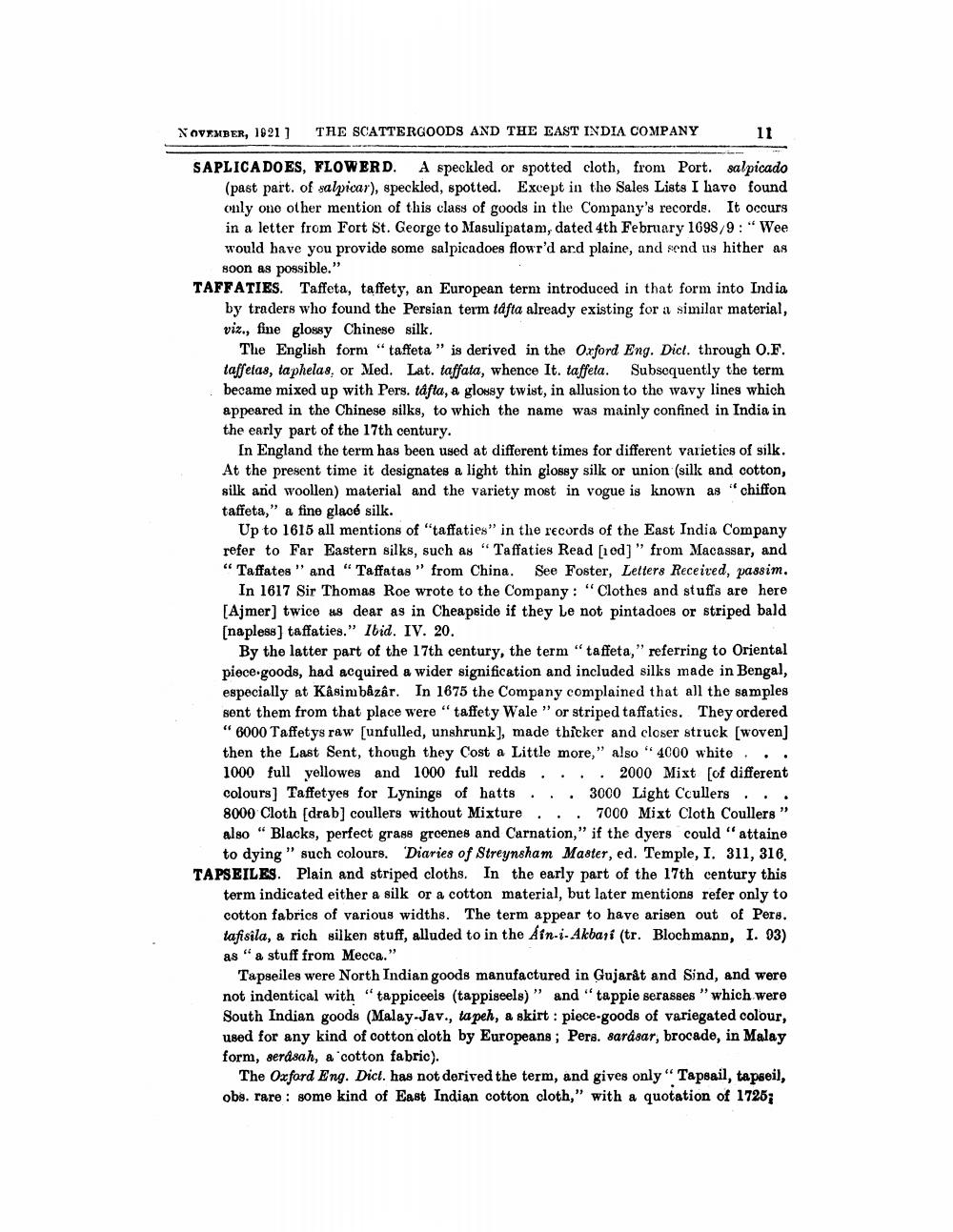________________
XOVEMBER, 1921)
THE SCATTERGOODS AND THE LAST INDIA COMPANY
11
SAPLICADO ES, FLOWERD. A speckled or spotted cloth, from Port. salpicado
(past part. of salpicar), speckled, spotted. Except in the Sales Lists I havo found only one other mention of this class of goods in the Company's records. It occurs in a letter from Fort St. George to Masulipatam, dated 4th February 1698/9: “Wee would have you provide some salpicadoes flowr'd ard plaine, and send us hither as
soon as possible." TAFFATIES. Taffeta, taffety, an European term introduced in that form into India
by traders who found the Persian term tafta already existing for a similar material, viz., fine glossy Chinese silk.
The English form "taffeta " is derived in the Oxford Eng. Dict. through O.F. taffelas, ta phelas. or Med. Lat. taffata, whence It. taffeta. Subsequently the term became mixed up with Pers. tafta, a glossy twist, in allusion to the wavy lines which appeared in the Chinese silks, to which the name was mainly confined in India in the early part of the 17th century.
In England the term has been used at different times for different varieties of silk. At the present time it designates a light thin glossy silk or union (silk and cotton, silk and woollen) material and the variety most in vogue is known as "chiffon taffeta," a fine glacé silk.
Up to 1615 all mentions of "taffaties" in the records of the East India Company refer to Far Eastern silks, such as "Taffaties Read siod" from Macassar, and “ Taffates" and "Taffatas" from China. See Foster, Letters Received, passim.
In 1617 Sir Thomas Roe wrote to the Company: "Clothes and stuffs are here [Ajmer) twice as dear as in Cheapside if they Le not pintadoes or striped bald [napless) taffaties." Ibid. IV. 20.
By the latter part of the 17th century, the term "taffeta," referring to Oriental piece.goods, had acquired a wider signification and included silks made in Bengal, especially at Kasim bâzâr. In 1675 the Company complained that all the samples sent them from that place were "taffety Wale " or striped taffaties. They ordered "6000 Taffetys raw (unfulled, unshrunk), made thicker and closer struck [woven] then the Last Sent, though they Cost a Little more," also " 4000 white... 1000 full yellowes and 1000 full redds ... 2000 Mixt [of different colours] Taffetyes for Lynings of hatts . 3000 Light Ccullers ... 8000 Cloth (drab) coullers without Mixture... 7000 Mixt Cloth Coullers" also "Blacks, perfect grass groenes and Carnation," if the dyers could " attaine
to dying " such colours. 'Diaries of Streynsham Master, ed. Temple, I. 311, 316. TAPSEILES. Plain and striped cloths. In the early part of the 17th century this
term indicated either a silk or a cotton material, but later mentions refer only to cotton fabrics of various widths. The term appear to have arisen out of Pers. tafisila, a rich silken stuff, alluded to in the Ain-1-Akbari (tr. Blochmann, I. 03) as "a stuff from Mecca."
Tapseiles were North Indian goods manufactured in Gujarat and Sind, and were not indentical with "tappiceels (tappiseels)" and "tappie serasses " which were South Indian goods (Malay-Jav., ta peh, a skirt : pioce-goods of variegated colour, used for any kind of cotton cloth by Europeans; Pers. sarásar, brocade, in Malay form, serdsah, a cotton fabric).
The Oxford Eng. Dict. has not derived the term, and gives only" Tapsail, tapeeil, obs. rare : some kind of East Indian cotton cloth," with a quotation of 1725;




